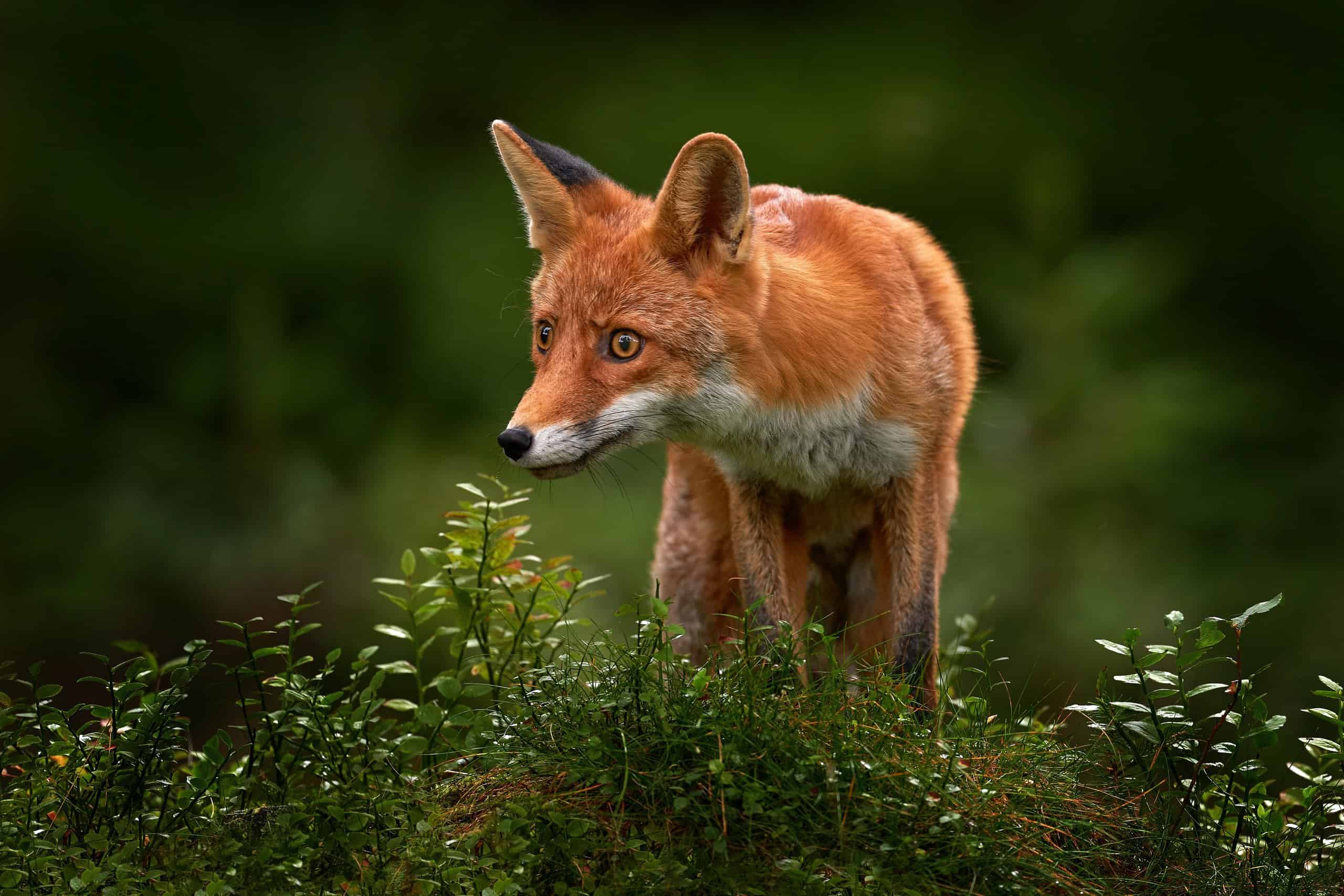Welcome to our comprehensive guide on foxes in Maine! We will delve into the various types of foxes found in the picturesque state and explore their habitats. Prepare to embark on an exciting journey as we uncover fascinating facts about these elusive creatures and discover where they call home.
Maine

The state of Maine has many wide open forests full of wild animals.
©Wirestock Creators/Shutterstock.com
Maine is a state located in the northeastern region of the United States. Bordered by the Atlantic Ocean, the Canadian province of New Brunswick, and the Canadian province of Quebec. Maine covers an area of 35,385 square miles (91,646 km²), making it the 12th largest state in terms of total area. The population of Maine in 2019 was estimated to be 1,344,212, making it the 39th most populous state in the US.
The capital of Maine is Augusta, and the largest city is Portland. This beautiful state has a rugged coastline, vast forests, rolling mountains, and deep lakes. It is home to Acadia National Park, the only ‘true’ national park in New England. Maine also has famously delicious seafood, particularly lobster, and its blueberry and wild blueberry products.
Maine is divided into 16 counties and contains 442 municipalities. The state’s economy is largely based on natural resources, particularly fishing, forestry, and agriculture. Manufacturing, tourism, health care, and finance are also important economic sectors in Maine. The state has the oldest median age in the US and is the least populous state east of the Mississippi River.
Maine has a strong sense of community and commitment to preserving its natural resources. The state has a long and proud history as one of the original 13 colonies and has been a leader in areas such as environmental protection and renewable energy. Maine is a beautiful and unique place to visit or call home.
2 Types of Foxes in Maine
Maine is lucky to have two species of fox: the red fox (Vulpes vulpes) and the gray fox (Urocyon cinereoargenteus). Although both species are similar in size, they have some distinct differences in their appearance, behavior, and distribution. Overall, both species contribute to the ecological balance of the state, and we should protect and appreciate them.
Red Fox
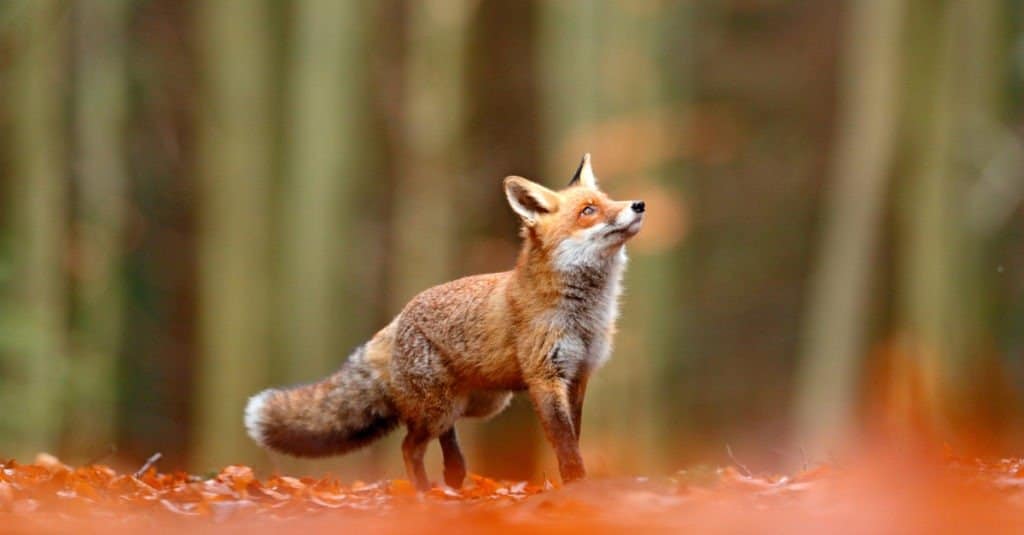
Maine is home to two beautiful types of foxes. One is the red fox.
©Ondrej Prosicky/Shutterstock.com
The red fox has bright orange-red fur, a white chest, and black legs and ears. They also have a lovely bushy orange tail with a tuft of white fur at the end. It is the most widely distributed fox species in North America and lives in both rural and urban areas. The red fox is an omnivore and typically feeds on small mammals, birds, and reptiles. It is mainly active at night and spends its days in shallow burrows or dens. An adult red fox generally weighs between 8 and 16 pounds. They have excellent hearing abilities and keen eyesight. Foxes can smell prey even when it is under the ground or buried in snow. They can also jump over six feet into the air! These senses make them wonderfully skilled hunters who can see, hear and pounce on their prey.
Gray Fox

One of the types of foxes in Maine is the gray fox which typically weighs between 9 and 11 pounds.
©Sean R. Stubben/Shutterstock.com
The gray fox is smaller than the red fox and has a gray-brown coat with a black-tipped tail and ears. Their tail has a black stripe running down the length of it. It is mainly found in the eastern United States, Mexico, and Central America. This fox species is an omnivore but prefers to feed on fruits, nuts, and small mammals. The gray fox is mainly active during the dawn and dusk hours and can climb trees to search for food. An adult gray fox typically weighs between 9 and 11 pounds. They have the same excellent eyesight, hearing, and smelling abilities as red foxes. They are also excellent predators of small animals and can even run up trees to catch birds and lizards.
Habitat
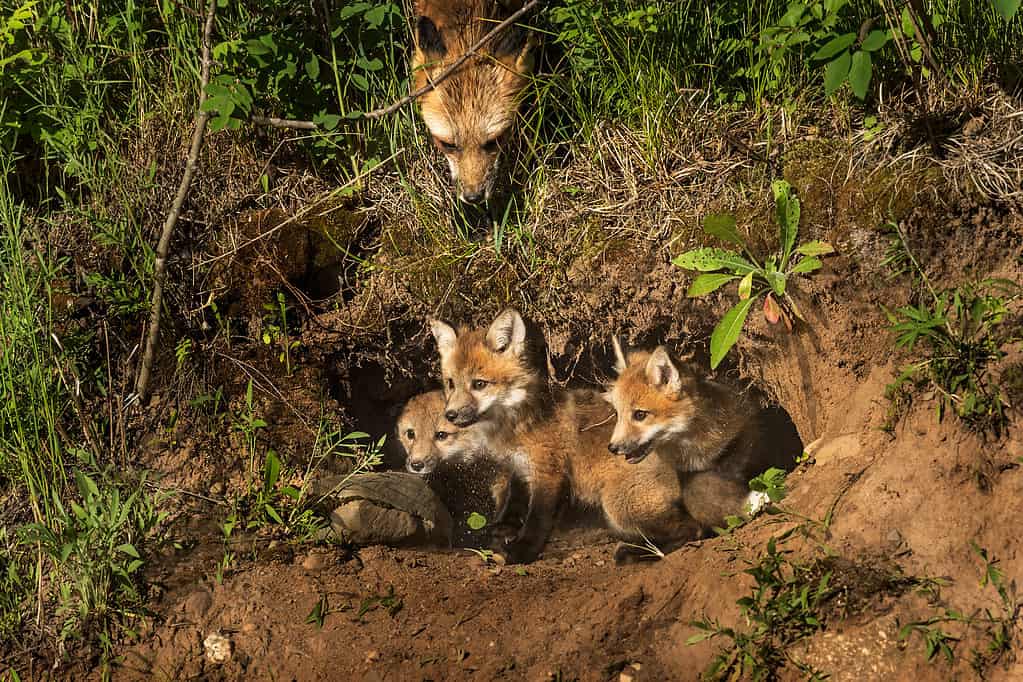
A mother red fox can create a den underground to keep her kits cool and safe.
©Geoffrey Kuchera/Shutterstock.com
Foxes have the ability to settle in a wide range of environments, and they are able to exist in close proximity to people. They frequently inhabit agricultural areas, where forests and open fields offer them a secure habitat. Coyotes are a threat to foxes, as they are more wary of humans, so foxes prefer to reside near humans in order to evade coyotes.
The red fox is plentiful and widespread throughout all of Maine, while the gray fox is more prevalent in the southern and mid-coast areas. Nevertheless, gray foxes are gradually moving further west into the middle parts of Maine.
It is important to recognize the importance of foxes and coyotes to the environment and to learn how to live alongside them. Through proper management, we can preserve their homes in Maine and keep them part of the local wildlife.
Diet
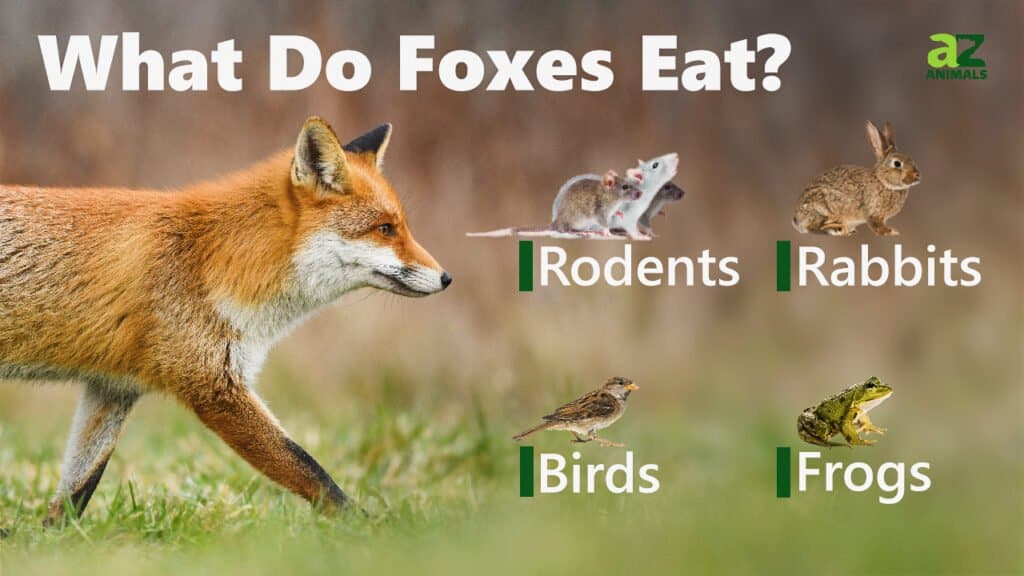
In addition to their omnivorous diet, foxes in Maine also have a diverse range of food sources available to them throughout the year. They primarily rely on small birds and mammals such as voles, mice, rats, bird eggs, and rabbits as their main source of protein. They are not limited to these prey items. Foxes also exhibit opportunistic feeding behavior. If snakes, carrion, insects, apples, berries, seeds, nuts, or corn are available, they will happily eat it.
Their ability to adapt their diet according to seasonal availability allows them to thrive in different environments. For instance, during the warmer months of spring and summer, resources are abundant. Pups need nourishment for growth and development. Foxes may be observed venturing out during daylight hours more frequently than usual to feed their growing children.
Foxes are primarily nocturnal creatures who conduct most of their hunting activities at dawn or dusk under cover of darkness. But fox sightings during the daytime are not entirely uncommon in Maine. This could be due to a variety of factors, such as favorable weather conditions or specific circumstances requiring them to search for additional sustenance outside their regular hunting times.
Overall though, foxes’ dietary flexibility contributes greatly to their survival in Maine’s varied ecosystems. They can efficiently exploit both animal and plant-based food sources, ensuring they maintain proper nutrition levels throughout the changing seasons. Understanding these feeding habits helps us appreciate the remarkable adaptability of these elusive creatures within our natural environment.
Reproduction
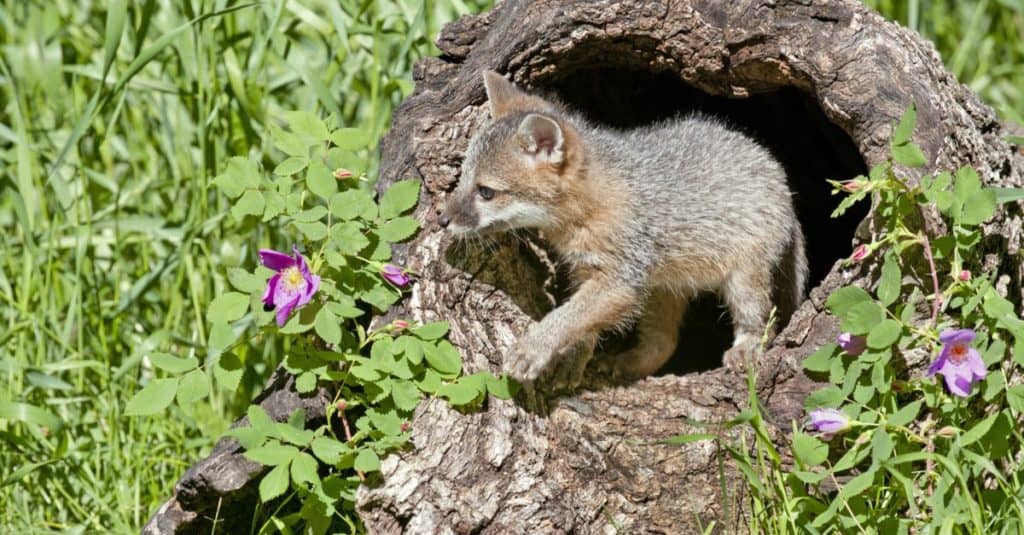
Gray fox mamas are very protective over their offspring.
©Scenic Shutterbug/Shutterstock.com
In the wilds of Maine, red and gray foxes engage in a fascinating reproductive cycle that typically takes place between January and March. During this time, these cunning creatures come together to breed, with gestation lasting anywhere from 50 to 63 days. As spring arrives, the female foxes give birth to litters consisting of an average of three to six adorable pups.
Interestingly, while both red and gray foxes exhibit similar breeding patterns, there are some noteworthy differences between them. Gray foxes are known for their monogamous nature, forming deep bonds with lifelong companions. These dedicated partners work together not only during the mating process but also throughout the entire upbringing of their offspring.
Once the young ones arrive into the world, both male and female gray and red foxes take on active roles in providing food and care for their newborns for up to three months. This nurturing behavior extends beyond basic survival necessities as they also impart valuable hunting skills onto their impressionable progeny.
Although these two types of foxes share many similarities in terms of parenting duties, it is important to note that they do not interbreed with each other. Each species maintains its distinct genetic lineage.
Foxes in Maine: Family Structure
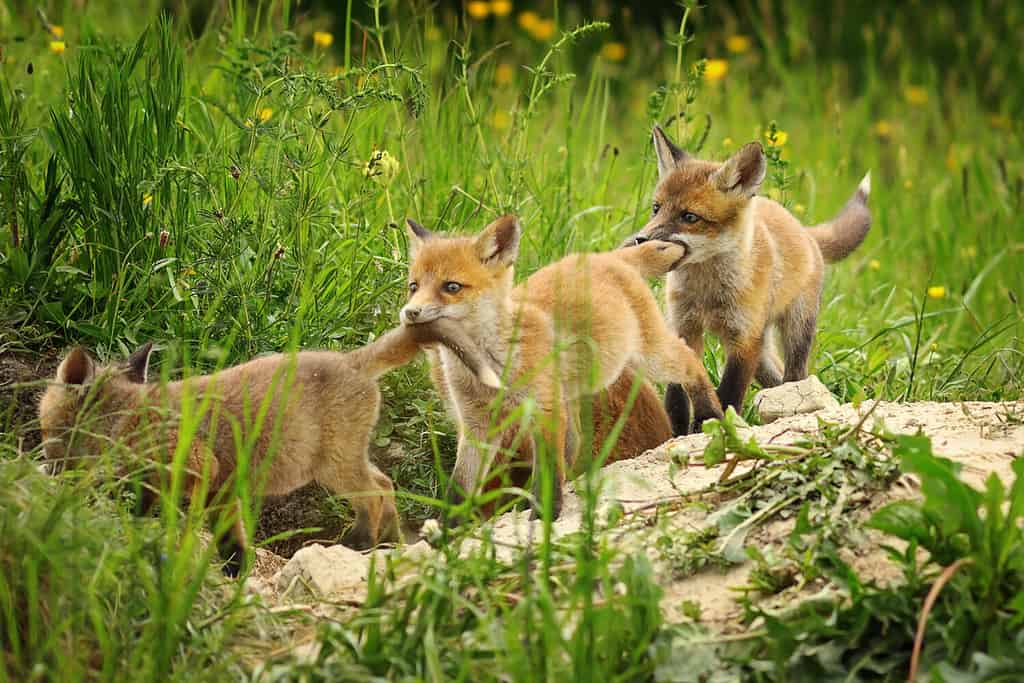
Young foxes are playful and learn to hunt through play.
©taviphoto/Shutterstock.com
During the reproduction period, family groups of foxes in Maine stay together until the month of September. It is during this time that the pups start to venture out from their natal home range, marking the beginning of their dispersal phase. Interestingly, male foxes tend to cover twice as much distance as females when searching for new territories, often traveling between 20 to 40 miles before finding suitable areas to settle.
A common pattern observed among female offspring is their inclination to either remain close or even share territories with their mothers. This behavior suggests a certain level of familial bond and potentially allows for cooperative benefits within these related individuals. In such cases, related females are more tolerant towards each other’s presence and coexist peacefully within shared spaces.
However, it becomes evident that unrelated female foxes have a different approach when it comes to territory boundaries. They strictly define and adhere to individual ranges, ensuring clear demarcation lines between themselves and other unrelated females nearby. This territoriality helps establish personal space and avoid conflicts over resources or potential competition.
Threats
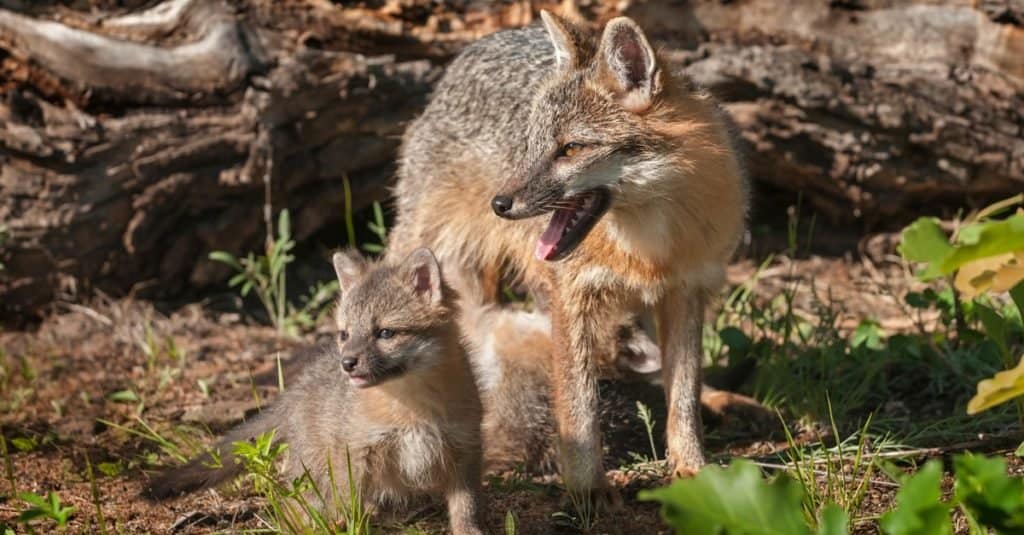
Humans are the biggest threats to a fox’s survival.
©Holly Kuchera/Shutterstock.com
Fox can become prey to coyotes, which means that they tend to avoid areas where coyotes are known to be common. As a result, it is less likely to come across foxes in regions heavily inhabited by their larger predator counterparts. However, the dangers faced by foxes extend beyond natural predators.
Another significant threat to fox populations is exposure to rat poison. Foxes are renowned for their exceptional rodent control abilities and often play an essential role in maintaining a balanced ecosystem. Unfortunately, this very skill puts them at risk of ingesting rat poison intended for rodents. This toxic substance not only poses a direct threat but can also indirectly harm these cunning creatures through secondary poisoning when they consume poisoned rats or mice.
Despite their elusive nature and agility, humans also pose a considerable mortality source for foxes. Human activities such as hunting and trapping can have devastating consequences on local fox populations if not regulated responsibly. Additionally, vehicle collisions present another danger that frequently results in fatal outcomes for these graceful animals.
As we strive towards coexistence with wildlife species like the beautiful and resourceful Maine foxes, it becomes imperative that we acknowledge and address the various threats they face from both natural factors like predation as well as human-induced perils such as pesticide use and indiscriminate hunting practices.
Thank you for reading! Have some feedback for us? Contact the AZ Animals editorial team.

